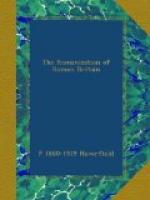These exceptions to the ruling Roman-provincial culture are probably commoner in Britain than in the Celtic lands across the Channel. In northern Gaul we meet no such vigorous semi-barbaric carving as the Gorgon and the Lion. At Trier or Metz or Arlon or Sens the sculptures are consistently classical in style and feeling, and the value of this fact is none the less if (with some writers) we find special geographical reasons for the occurrence of certain of these sculptures.[1] Smaller objects tell much the same tale. In particular the bronze ‘fibulae’ of Roman Britain are peculiarly British. Their commonest varieties are derived from Celtic prototypes and hardly occur abroad. The most striking example of this is supplied by the enamelled ‘dragon-brooches’. Both their design (Fig. 19) and their gorgeous colouring are Celtic in spirit; they occur not seldom in Britain; on the Continent only four instances have been recorded.[2] Here certainly Roman Britain is more Celtic than Gallia Belgica or the Rhine Valley. Yet a complete survey of the brooches used in Roman Britain would show a large number of types which were equally common in Britain and on the Continent. Exceptions are always more interesting than rules—even in grammar. But the exceptions pass and the rules remain. The Castor ware and the Gorgon’s head are exceptions. The rule stands that the material civilization of Britain was Roman. Except the Gorgon, every worked or sculptured stone at Bath follows the classical conventions. Except the Castor and New Forest pottery, all the better earthenware in use in Britain obeys the same law. The kind that was most generally employed for all but the meaner purposes, was not Castor but Samian or terra sigillata.[3] This ware is singularly characteristic of Roman-provincial art. As I have said above, it is copied wholesale from Italian originals. It is purely imitative and conventional; it reveals none of that delight in ornament, that spontaneousness in devising decoration and in working out artistic patterns which can clearly be traced in Late Celtic work. It is simply classical, in an inferior degree.
[Footnote 1: Michaelis, Loeschke and others assume an early intercourse between the Mosel basin and eastern Europe, and thereby explain both a statue in Pergamene style which was found at Metz and appears to have been carved there and also the Neumagen sculptures. As all these pieces were pretty certainly produced in Roman times, the early intercourse seems an inadequate cause. Moreover, Pergamene work, while rare in Italy, occurs in Aquitania and Africa, and may have been popular in the provinces.]
[Footnote 2: I have given a list in Archaeologia Aeliana, 1909, p. 420, to which four English and one foreign example have now to be added. See also Curle, Newstead, p. 319, and R.A. Smith, Proc. Soc. Ant. Lond., xxii. 61.]




